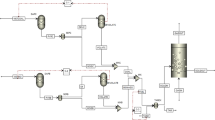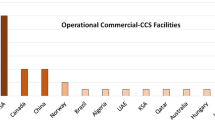Ninety-eight percent of the pig iron produced in the world is made in blast furnaces. Pig-iron smelting is presently being impacted by a serious shortage of coking coals. Moreover, the production of coke used in the smelting operation has an adverse effect on the environment. One method of partially replacing coke in the smelting operation is to inject hydrocarbons into the blast furnace. The injection of hydrocarbon through the tuyeres alters the mass- and heat-transfer conditions inside the furnace and increases the volume and hydrogen content of the hearth gases and top gases. The hydrogen content of the gases depends on the value of the C/H2 ratio in the fuel that is injected. All these changes decrease the amount of direct reduction that iron undergoes in the furnace. This article presents results from model calculations that took into account the complex effect of injected hydrocarbons on reduction and heat exchange in a blast furnace. The models were used to quantitatively estimate the amount of reduction that takes place and to determine the value of a coefficient which characterizes the replacement of coke by injected fuel. The calculations that were performed make it possible to predict changes in coke consumption in a blast furnace when it is injected with liquid hydrocarbons.

Similar content being viewed by others
References
A. Babich, D. Senk, H. W. Gudenau, and K. Th. Mawrommatis, Ironmaking, RWTH Aachen University. Aachen (2008).
V. G. Lisienko, A. V. Lapteva, and Yu. N. Chesnokov, “Comparative ecological and greenhouse analysis of alternative coke-less processes for making pig iron and steel,” Metallurgist, 55, No. 7–8, 471–477 (2011).
P. Pustejovska, S. Brozova, S. Jursova, “Environmental benefits of coke consumption decrease,” Metal 2010: 19th Int. Conf. on Metallurgy and Materials, May 18–20, 2010, Roznov pod Radhostem, Czech Republic, Tanger, spol. s r. o., Ostrava, ISBN 978-80-87294-17-8, pp. 79–83.
S. Jursova, “Metallurgical waste and possibilities of Its processing,” ibid, pp. 115–120.
J. Bilík, “Analytical models of blast furnace operation in current metallurgical industry,” Hutnické Listy, LIV, No. 7–8, 13–16 (1999).
J. Sousek, Analysis of Injection of Hydrocarbon Fuels Results on Base Blast Furnace Energy Balance: Master’s Thesis [in Chech], VSB – TU, Ostrava (2011).
Author information
Authors and Affiliations
Corresponding author
Additional information
Translated from Metallurg, No. 12, pp. 38–40, December, 2012.
Rights and permissions
About this article
Cite this article
Pustejovska, P., Jursova, S., Brozova, S. et al. Effect of Waste and Alternative Fuels on Blast-Furnace Operation. Metallurgist 56, 908–911 (2013). https://doi.org/10.1007/s11015-013-9673-5
Received:
Published:
Issue Date:
DOI: https://doi.org/10.1007/s11015-013-9673-5




